List Visual Arts Center
The mission of the List Visual Arts Center (LVAC) is to present the most challenging, forward-thinking, and lasting expressions of modern and contemporary art to the MIT community and general public in order to broaden the scope and depth of cultural experiences available on campus. LVAC's mission also includes reflecting and supporting the diversity of the MIT community through the presentation of diverse cultural expressions.
These goals are accomplished through four avenues: changing exhibitions of contemporary art in all media by the most advanced visual artists working today that take place in the LVAC galleries (E15); the permanent collection of art (comprising large outdoor sculptures, artworks sited in offices and departments throughout campus, as well as art commissioned under MIT's Percent-for-Art policy, which allocates funds from new building construction or renovation for art); the Student Loan Art program, a collection of fine art prints, photos, and other multiples, maintained solely for loan to MIT students during the course of the academic year; and extensive interpretive programs to offer the MIT community and the public various perspectives about LVAC changing exhibitions and MIT's art collections.
Current Goals
- Continue to present the finest international contemporary art that has relevance to the MIT community.
- Institute new guest curator program.
- Preserve, conserve, and resite works from the permanent collection.
- Make needed alterations to the gallery spaces.
- Continue to increase audience both from MIT campus and from Boston area.
- Increase cross-disciplinary and collaborative use of LVAC's exhibitions, programs, and facilities.
- Increase web-based projects and information to parallel MIT's OpenCourseWare program.
Accomplishments
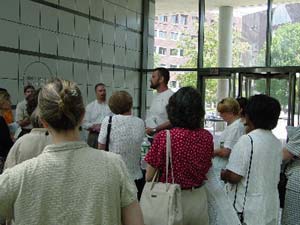 Curator Bill Arning leading a tour. Photo by Hiroko Kikuchi. Courtesy of List Visual Arts Center. |
- Increased attendance to 16,319, the highest numbers since 1994, when actual attendance counts replaced estimated figures.
- Offered weekly gallery tours led by an LVAC staff member on Wednesday and Sunday afternoons. The tours were open to MIT faculty, staff, and students as well as the general public.
- Provided tours of exhibitions and the permanent art collection on campus to 91 groups.
- Implemented a second year of programming of a new exhibit space, the Media Test Wall. This 8' x 8' rear-projection screen located the hallway of MIT's Building 56 features a compilation of videos by contemporary artists that play in a continuous loop 24 hours a day.
- LVAC staff were named commissioner by two national panels to organize the US participation at the Venice Biennale (curator Kathy Goncharov; artist Fred Wilson) and Cairo Biennial (director Jane Farver; artist Paul Pfeiffer).
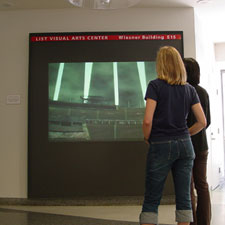 The Media Test Wall. Photo by John Buck. Courtesy of List Visual Arts Center. |
- Made loans of 278 artworks to various departments and individuals across the MIT campus.
- Offered the Wasserman Forum on Contemporary Art to a full house in Room 10-250.
- Received more than 100 positive critical reviews for exhibitions, including reviews in the Boston Globe, the Boston Herald, the Boston Phoenix, the Boston Metro, Boston Magazine, the New York Times, Art on Paper, Arts Media, Art New England, the Harvard Crimson, Architectural Record, the Associate Press, Yomiuri Newspaper, The Tech, Bomb Magazine, Modern Painters, and numerous web publications.
- Completed a commission by artist Matthew Ritchie to create a new work for the Zesiger Sports and Fitness Center.
- Made purchases or received donations of 51 new works to add to the Student Loan Art Program, the majority of which were exhibited in the Stratton Student Center during the academic year. They will be cycled into the lending collection in the fall of 2003.
- Prepared for the American Association of Museum's site visit and 10-year re-accreditation, scheduled for fall 2003.
- Completed an inventory of all public art in the east and northeast zones of the MIT campus.
- Updated and distributed a color map of the MIT campus highlighting 35 major public art works.
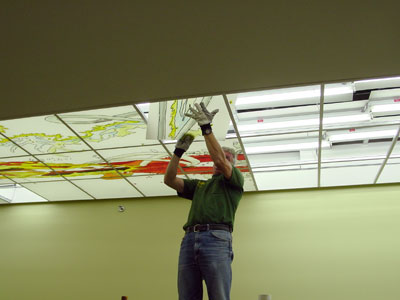 Matthew Ritchie's new work being installed in the Zesiger Sports and Fitness Center. Photo by Kathleen Goncharov. Courtesy of List Visual Arts Center. |
- Hosted residencies by artist Paul Pfeiffer and Cai Guo-Qiang in collaboration with the Artist-in-Residence Program of the Office for the Arts. An exhibition of Pfeiffer's work was held in early 2003.
- Presented Race in Digital Space, which debuted at the MIT List Visual Art Center as part of the USC-MIT Conference on Race in Digital Space, at the Spelman College Museum of Fine Art.
- Conserved Nicolas Schöffer's sculpture Spatiodynamique, which is to be reinstalled in Building 66 in late 2003, and repainted Tony Smith's For Marjorie, the large-scale red sculpture near Tang Residence Hall.
- Conserved paintings by Olitski, Davis, Bhavsar, Anusckiewicz, and Kaldis, which have been reinstalled in Sidney-Pacific and the Sloan School Library.
- Began conservation of Harry Bertoia's Altarpiece for MIT Chapel after securing outside funding.
- Participated in Freshman Arts Program Orientation, Family Weekend, and Campus Preview Weekend programs, providing tours and receptions.
- Began collaborative exhibition project with the Museum of Contemporary Art Taipei in Taiwan for an exhibition to be hosted there and at the LVAC on the effect of technology on the human senses. This exhibition will be organized by an international team of curators from Japan, Germany, and Taiwan, with participation by MIT professors Caroline Jones and Chris Csikzentmihaly.
- Hosted graduate receptions.
- Facilitated the List Essay Prize for writing on contemporary visual art, which was won by undergraduates John Wallach and Evan Pruitt.
- Expanded ArtWorks, an after-school program that provides tours and seminars for students interested in careers in the arts, to the home-schooled population. Students met with the web-design firm Partners and Simons, art conservators from Harvard University's Straus Center for Conservation, and costumers from Boston Ballet.
- Published first online catalogue, Influence, Anxiety, and Gratitude, in keeping with the spirit of MIT's OpenCourseWare project.
Exhibitions
Media Test Wall: Spinning (Spring-Fall 2002). The second video compilation examined how 12 video artists have incorporated the symbolic effects of spinning into their work. The 10 videos compiled explored the ongoing fascination among artists, philosophers, and scientists with the spinning sphere.
Student Loan Art Exhibition (September 3–September 15, 2002)—annual exhibition of 350 works comprising Student Loan Art Collection. MIT students may view displayed works and then enter a lottery to be awarded the work of their choice on loan for the academic year to hang in their dormitory, apartment or office.
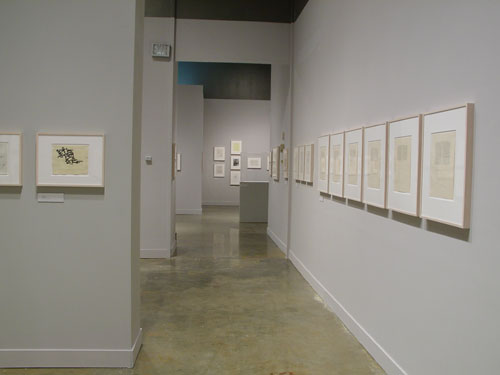 Installation view of After the Beginning and Before the End. The Gilbert & Lila Silverman Collection. |
After the Beginning and Before the End, the Gilbert & Lila Silverman Collection (October 17, 2002–January 5, 2003)—a selection of 220 "instructional drawings" compiled from the collection of Gilbert and Lila Silverman. The exhibition displayed the paper evidence of works that were created or performed. With key artists such as Piet Mondrian, Henry Moore, John Baldassari, Yoko Ono, and Hans Haacke, this exhibit had already received international recognition.
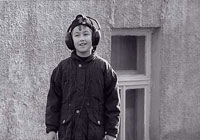 Still from Laila Pakalnina's Papa Gena. Courtesy of List Visual Arts Center. |
Viesturs Kairiss/Ilmars Blumbergs: Magic Flute—two videos, produced and shown in Riga in 2001, for the Latvian capital's 800th anniversary, and subsequently screened at the Venice Biennale, that explore contemporary culture through Mozart's music.
Media Test Wall: William Wegman: Selected Video Works 1970-78 (Winter 2003). The works of William Wegman, one of the foremost pioneers in video art, were a provocative presentation for the Media Test Wall's third showing. Costarring a Weimeraner named Man Ray, these pieces of video art history displayed Wegman's creative ability and whimsical intellect.
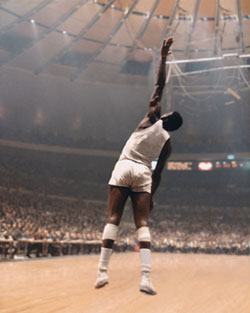 Paul Pfeiffer's Four Horsemen of the Apocalypse. Courtesy of List Visual Arts Center. |
Paul Pfeiffer (February 6–April 6, 2003)—an exhibition of 17 new and recent works in digital and other media. Pfeiffer, whose work explores universal themes of identity, race, and culture, often through imagery from sports, film and popular culture, created a major new work for this presentation, which was cocurated by LVAC director Jane Farver and MCA Chicago curator Dominic Molon. The exhibition is traveling to Chicago and Honolulu.
Rapid Eye Movement—a film by Runa Islam. In this brief film, the artist takes the understanding of film as a form of collective dreaming as a starting point for a luscious cinematic adventure. Six strangers on an extended train trip doze and dream, and in the convoluted logic of dreams, their stories overlap.
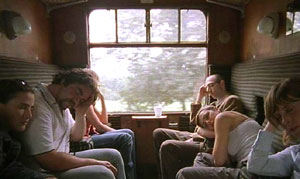 Still from Runa Islam's Rapid Eye Movement. Courtesy of List Visual Arts Center. |
Media Test Wall: Just Stand There! (Spring 2003). Five artists from around the world examined the spiritual, philosophical and aesthetic conditions of standing still. In this fourth installation, the presence and absence of stillness were utilized to provoke contemplation, self-reflection, and humor.
Media Test Wall: Salon D'Arte Digitalia (Spring 2003). Technology has become a medium of images, sounds, and interactions that can only be created through computers. This program selected eight teams of designers and artists who have taken the challenge to express themselves via web-based media and to explore the aesthetics of technology. The program was a collaboration with Bottlecap Studios, a design firm, in conjunction with Boston's biennial CyberArts Festival.
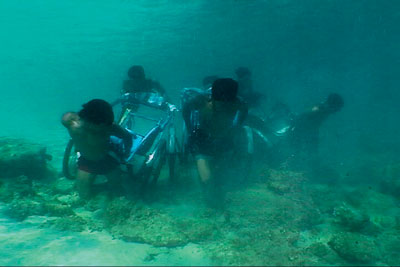 Still from Jun Nguyen-Hatsushiba's Memorial Project Nha Trang, Vietnam: Towards the Complex—For the Courageous, the Curious, and the Cowards. Courtesy of List Visual Arts Center. |
Memorial Project Nha Trang, Vietnam: Towards the Complex—For the Courageous, the Curious, and the Cowards (April 8–July 6, 2003). Born in Japan, educated in the United States, and now living in Vietnam, the artist filmed this remarkable 13-minute video on location in Vietnam's Indochina Sea. It depicts a number of young men struggling to propel cyclos across the rock-strewn, sandy, ocean bottom in an all-too-real metaphor for this endangered way of life.
Influence/Anxiety and Gratitude (May 8–July 6, 2003)—an exhibition, curated by Bill Arning, of 59 works by 33 artists or artists groups that reconsidered influence, which is overlooked in contemporary art, as inherent to all cross-generational dialogue. It included several performances, a web project, and an online catalogue.
Media Test Wall: The Way Things Go (Summer 2003). The Swiss collaborative team of Peter Fischli and David Weiss uses commonplace items for specific purposes in a symphonic series of interactions. Harking back to the works of Rube Goldberg, they magically create an extraordinary 30-minute sequence of actions embedded with physics, fire, and magic.
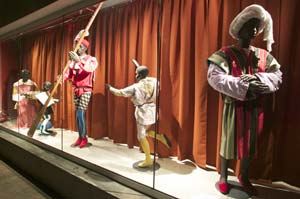 Installation view of Fred Wilson: Speak of Me As I Am at the Venice Biennale. Photo by Robert Ransick. Courtesy of List Visual Arts Center. |
Fred Wilson: Speak of Me as I Am (June 12–November 2, 2003). As the official presentation of the United States at the 50th Venice Biennale, LVAC organized a five-room installation, curated by Kathy Goncharov, of New York-based artist Fred Wilson's exploration of the role and images of "Moors" in Venetian art, history, and culture, past and present.
Interpretive Program Highlights
- LVAC curatorial and education staff led 96 gallery tours for such groups as MITAC, Visual Arts Program, Sloan Vintners Club, Boston University, Boston College, UMass Boston, Massachusetts College of Art, School of the Museum of Fine Arts, Vietnamese Community Center, Summer Discovery Program, Boston Arts Academy, Newton Arts Center, Art Table, UMass Amherst, Rhode Island School of Design, Harvard International Women's Group, Boston Society of Architects, Art Institute of Boston, Teachers as Scholars, Mystic Learning Center, and Creative Allies.
- The Annual Max Wasserman Forum on Contemporary Art was attended by 425 people. The panel discussion, "Post-revolutionary Sex and the Future of Visual Desire," was moderated by cultural critic Bruce Hainley, with panelists filmmaker Larry Clark, artist Glenn Ligon, and artist Claude Wampler. The respondent was Elaine Sturtevant, an artist who was a visiting professor in MIT's Visual Arts Program.
- LVAC participated in the Boston CyberArts festival through a presentation of Jun Nguyen-Hatsushiba's Memorial Project in the gallery and Salon D'Arte Digitalia on the Media Test Wall.
- Runa Islam spoke at an artist talk in conjunction with her exhibition.
- LVAC hosted two of the School of the Museum of Fine Arts' sculpture talks with artists Jonathan Seliger and Rita McBride.
- Early video curator Russell Connor and Peter Walsh were panelists for "A Discussion about TV and Video Art" and presented a selection of early videos from WGBH, in conjunction with MIT's Comparative Media Studies conference "Media in Transition 3."
In conjunction with After the Beginning and Before the End, the program held a panel discussion with artist Carolee Scheneemann, collector Gilbert Silverman, archivist Jon Hendricks, and curator Jan van der Marck; and sponsored gallery lectures by MIT Media Lab professor and designer John Maeda and MIT Visual Arts Program professor and artist Kryzysztof Wodiczko.
The program held an artist's talk by Paul Pfeiffer and presented a lecture by MIT professor Henry Jenkins on contemporary art and horror films in conjunction with Paul Pfeiffer.
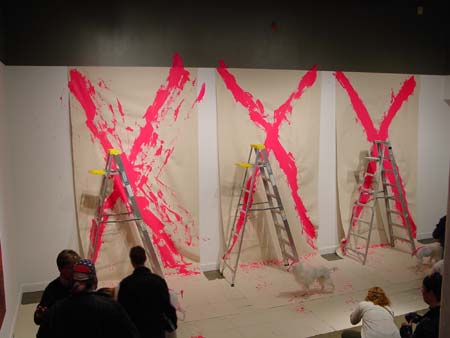 Conclusion of performance of Triple XXX Rose by artist AA Bronson. Photo by J. Douillette. Courtesy of List Visual Arts Center. |
In conjunction with Influence/Anxiety and Gratitude, the program sponsored curator's talks by Caroline Jones, Martha Buskirk, Scott Rothkopf; General Idea/AA Bronson: Triple XXX Rose; an artist talk by Simon Leung; Stuart Netsky's Mile Long Drawing performance; an exhibition talk for Boston-area collectors; and a lecture by Lewis Hyde.
Collections
Permanent Collection
There were 95 gifts of art to the collection, including works by Robert Mangold, Ida Applebroog, Petah Coyne, Lorna Simpson, Nayland Blake, Jasper Johns, Tim Rollins & KOS, and Jo Sandman. Donors included Vera G. List, Dorothy and Roy Lavine, Herb and Kitty Glantz, Joan and Gerald Kimmelman, and Eileen and Michael Cohen. Two works by Jun Nguyen-Hatsushiba and Mike Kelley/Paul McCarthy were purchased.
Percent for Art
With many major new MIT construction and renovation projects underway, curator Kathy Goncharov and consultant Patricia Fuller oversaw the continued development of several artworks. Matthew Ritchie's installation in the Zesiger Sports and Fitness Center opened in the fall, while construction is well underway for an installation by Dan Graham in the Simmons Hall dormitory, which will open in fall 2003. The team organized to develop the art program for the Sidney Pacific dorm has selected Sarah Sze to present a proposal, while Jenny Holzer is presenting a proposal for the Vassar Streetscape. Explanatory brochures are being prepared for new projects with the assistance of Furthermore: a program of the J. M. Kaplan Fund.
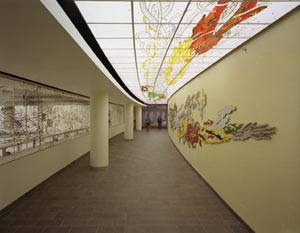 Matthew Ritchie's installation in the Zesiger Sports and Fitness Center. Photo by John Buck. Courtesy of List Visual Arts Center. |
Student Loan Art Program Collection
The Student Loan Art program attracted 1,183 MIT students to the LVAC gallery over the period of the exhibition of artworks. A total of 1,118 students submitted entries to the lottery to borrow artwork, and approximately 319 works were disbursed. A special web site dedicated to this program was launched during the summer of 2002.
Administrative Changes
- LVAC provided training for 15 interns from Rhode Island School of Design, Tufts University, Massachusetts College of Art, School of Museum of Fine Arts, Yale, and Brandeis, as well as individuals who have previously completed school.
- LVAC's curator and public art curator took on the responsibility of serving as freshman advisors to seven students. In addition to providing academic counseling, they organized several arts activities during the fall.
Finances/Funding
- Paul Pfeiffer received donations from Gucci of $30,000, and Art/Pace of $3,000.
- Influence/Anxiety and Gratitude received several donations: $3,000 from the Barbro Osher Pro Suecia Foundation; $1,750 from the Embassy of Sweden; $1,500 from the Goldberger Foundation; $1,000 from the American-Scandinavian Foundation; and $500 from the Canadian Consulate General in Boston
- After the Beginning and Before the End was awarded a $5,000 grant from the Fifth Floor Foundation.
- Percent for Art brochures are being produced with a $5,000 award from Furthermore: a program of the J.M. Kaplan Fund.
- Other support came from the Institute of Museum and Library Services, the Council for the Arts at MIT, the Massachusetts Cultural Council, and Dorothy and Leroy Lavine.
- The restoration of artworks on campus received the support of William R ('56) and Betsy P Leitch, the National Endowment for the Arts and the David W. Bermant Foundation: Color, Light, Motion.
- Martin Zimmerman is awarding funds to permit the use of outside curators to supplement the List Center staff.
- Special receptions for MIT graduate students were awarded $7,700 by Dean Isaac Colbert.
- The US Pavilion at the Venice Biennale was supported by over 30 generous individuals, foundations, companies and organizations, along with the Fund for US Artists at International Festivals and Exhibitions, a partnership of the US Department of State, the National Endowment for the Arts, the Pew Charitable Trusts, and the Rockefeller Foundation.
- In-kind donations were received from the Hotel@MIT, Cambridge SoundWorks, Trader Joe's, the Canadian Consulate General, Phoenix Media Communications Group, Boston Herald, and Harpoon Brewery.
Future Goals
- The LVAC web site will provide information about the Student Art Loan program (which is currently under development) and the permanent collection. It will also provide additional opportunities for artists to do web-based projects, beginning with Matthew Ritchie, who is creating a new work for the Zesiger Sports and Fitness Center under the Percent-for-Art program. The site's development requires outside expertise and staff training.
- LVAC plans to develop comprehensive educational materials about all of the MIT Percent-for-Art projects. We would like to create documentary videotapes about the Percent-for-Art and artist residency project. This project will require additional funding and expertise.
- Development is in the works for a comprehensive program of exhibitions and public programs consistent with MIT's mission that can attract large-scale funding.
- LVAC plans to expand upon the Media Test Wall's effort to present art in other sites on campus, beginning in the coming year with a small exhibition of works by contemporary Japanese artist Yukinori Yanagi for the MIT Japan Program offices.
- LVAC will develop web-based systems for providing self-guided tours and for implementing exhibition organization and better in-house communication.
Personnel Information
Director Jane Farver participated in grant-making panels for Etant-Donnes for the Government of France in Paris and Chicago. She was a panelist for the Bogliasco Foundation (Genoa), conducted studio critiques, and was a juror for the School of the Museum of Fine Arts Boston. She contributed essays to ART/Asia Pacific magazine and an exhibition catalogue at the Americas Society in New York, and was named commissioner for the United States's participation in the Cairo Biennial.
Curator Bill Arning presented lectures at Massachusetts College of Art, the School of the Museum of Fine Art, Rhode Island School of Design, Maine College of Art, and Montserrat College. Recent catalog essays include "Type A: The Pre-Career Retrospective" for the Luckman Fine Arts Complex, California State University, Los Angeles and "Hidden Inside, Melissa McGill," an artist book published in conjunction with her residency at Kohler Arts Center. He also serves on the board of White Columns, ONI Gallery, and the Gallery at Green St. He was named Best Curator in Boston by Boston Magazine, and his exhibition Mirror, Mirror was named one of the Best Exhibitions in Boston in 2002 by the International Art Critics Association.
Kathy Goncharov, curator of public art, was named commissioner of the US Pavilion at the Venice Biennale; the exhibition opened in June.
The MIT List Visual Arts Center advisory board and staff members were deeply saddened by the passing of Vera G. List, longtime advisor, patron, and art donor.
More information about the List Visual Arts Center can be found at http://web.mit.edu/lvac/.